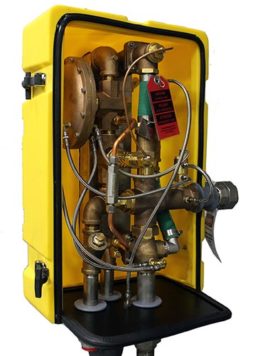Tepid water solutions
For tepid water solutions, what are the best environments for steam and electric? What are the benefits and drawbacks of each?

Responding is Alexis Rose, industrial product and sales manager, ThermOmegaTech Inc., Warminster, PA.
Emergency safety shower and face/eyewash stations are vital to ensuring worker safety and guideline compliance in any industrial facility where potentially hazardous chemicals, debris or other materials may come in contact with and endanger employees.
These safety fixtures must be properly supplied with tepid water – 60°-100° F – at all times to protect personnel from further injuries and encourage users to perform the full 15-minute recommended flush. Arguably the most important factor when implementing an emergency fixture, all emergency safety stations are dependent on and only as good as the delivery system from which they draw.
To ensure a continuous and instantly available supply of tepid water to safety stations, industrial facilities may incorporate an electric heating system, a steam-fired solution or a mix of the two.
Electric water heating solutions
Electric heating systems are offered in a variety of configurations, but often consist of either a tank water heater in which water is heated and stored for use, or a tankless system that heats water at the point of use. These systems are fairly hassle-free to install indoors and ideal for industrial facilities that don’t have an existing steam supply that can be repurposed for heating tepid water.
However, disadvantages associated with electric heating systems often limit their implementation. Plants with combustible vapors present must heavily insulate electrical systems to prevent dangerous sparks or invest in costly preinsulated units. These units often can’t withstand extremely cold temperatures, confining them primarily to indoor installations.
Additionally, should the facility lose power, the unit will no longer function. Tank configurations can retain their heat for a considerable amount of time, while point-of-use electric heating systems become purely ornamental. Although appropriate for certain facilities, electric heating systems’ disadvantages often render them the lesser option when selecting a tepid water supply solution.
Steam-fired tepid water solutions
Steam-fired tepid water delivery systems use a facility’s existing steam supply to heat water to an OSHA-compliant temperature. Most often offered in a tankless, point-of-use configuration, tank designs are also available.
Mechanically operated, steam-fired systems are particularly ideal for facilities with explosion-proof requirements. These solutions don’t use electricity to operate, so there’s no need for costly insulation or risk of a frayed wire resulting in combustion of hazardous vapors. Durable and versatile in application, these systems may be installed indoors or outdoors with no need for additional insulation or coverings because of steam’s inherently “self-heating” nature. Further, should the facility lose power, the unit will continue to operate as long as water pressure is maintained and the water temperature is tepid.
Because a facility’s tepid water delivery needs and configuration restrictions are rarely clear cut, many employers elect to implement a mix of electric heating and steam-fired solutions. When evaluating whether a steam-fired or electrical tepid water delivery system is appropriate for your facility, always be sure to confirm that its tepid water delivery specifications conform to OSHA and ANSI recommendations for both water temperature output and flow rates.
Editor's note: This article represents the independent views of the author and should not be construed as a National Safety Council endorsement.
Post a comment to this article
Safety+Health welcomes comments that promote respectful dialogue. Please stay on topic. Comments that contain personal attacks, profanity or abusive language – or those aggressively promoting products or services – will be removed. We reserve the right to determine which comments violate our comment policy. (Anonymous comments are welcome; merely skip the “name” field in the comment box. An email address is required but will not be included with your comment.)

